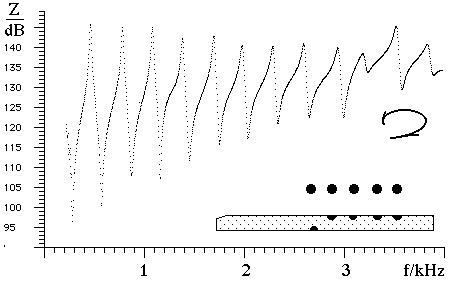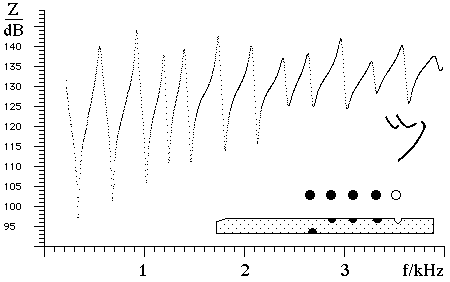Some shakuhachi acoustics
This site gives some preliminary information about our measurements
of the acoustics of the shakuhachi, and of the shakuhachi player.
We measure a quantity called the acoustic impedance spectrum,
which may be considered as the response of the instrument
to all frequencies. This quantity is measured on the instrument
itself, without a player. For an explanation of this quantity,
see What
is acoustic impedance?. For a preliminary introduction
to the acoustics of the flute family, see Introduction
to flute acoustics.
 
The acoustic impedance spectrum of the shakuhachi, measured
at the input, for the standard fingerings for the notes ro
and tsu. The impedance is plotted in dB, i.e. 20 log
(Z/Pa.s/m^3). The instrument measured was a Bei
Shu model (Nagano Ken, Japan).
Abstract for the 140th meeting of the Acoustical Society
of America, 6 December 2000
Some acoustics of the shakuhachi--and of the shakuhachi
player's face. Joe
Wolfe and John
Smith
The shakuhachi is an end-blown Japanese flute. Like other
flutes, it is open at the place of excitation, so it operates
at minima of the acoustic impedance. The jet interacts with
both the bore impedance and the radiation impedance, which
is baffled by the player's face. Large changes in the relative
geometry of the instrument and the face contribute to the
flexibility in pitch and timbre that are important elements
of the traditional playing style, and which gives the instrument
much of the expressiveness for which it is renowned.
We report measurements of the impedance spectra (Z(f)) of
the bore, and of the baffled radiation load imposed on the
jet. Z(f) of the instrument differs from that of the Western
flute family because the shakuhachi has neither the narrow
chimney of the Western flute, nor the short resonator upstream
of the jet. These influence the overal form of Z(f) for the
instrument. Other features of Z(f) are explained by the tone
hole position and geometry. The Z(f) of the radiation field
varies for different playing positions, which has important
effects on the tuning of the minima and on the spectral response.
A lay
language version of this conference paper is available.
Some related publications. The first of these papers
compares the shakuhachi with Western flutes. The second is a
technical study of Western flutes from the classical and modern
periods. Both are .pdf files.
- Wolfe, J. and Smith, J. (2000) "Acoustics
of the air-jet family of instruments". Proc. Seventh
Western Pacific Regional Acoustics Conf., Kumamoto,
Japan, pp 575-580.
- Wolfe, J., Smith, J., Tann, J. and Fletcher, N.H. "Acoustic
impedance of classical and modern flutes" Journal
of Sound and Vibration (in press).
There is a more detailed discussion of flute acoustics in the
main flute
site, and in some of our research
papers on this topic. We also recommend The Physics of
Musical Instruments by N.H. Fletcher and T.D. Rossing (New
York: Springer-Verlag, 1998). For the non-scientific reader,
there is also an introduction to How
do woodwind instruments work..
Our collaborators are the shakuhachi maker Tom
Deaver, of Nagano Ken, Japan, and the shakuhachi player
Riley Lee, of Springwood,
Australia. We thank them for their assistance.
The International Shakuhachi
Society has more information, and links to other shakuhachi
sites. |

